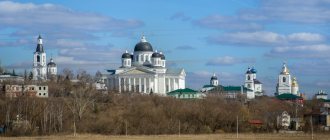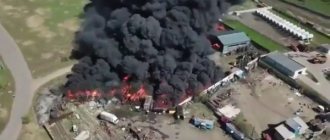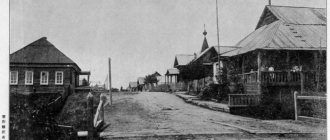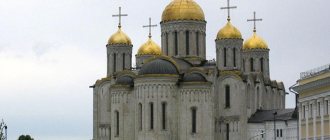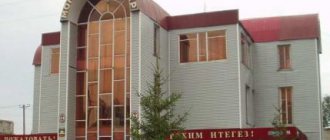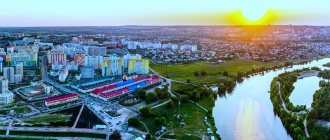Malmyzh
(Kirov region)
OKATO code:
33223501
Founded:
15th century.
City since:
15th century
City of district subordination (Malmyzh district, Kirov region) Center:
Malmyzh district
Telephone code (reference phone)
| 83347***** | 22-2-22 |
Deviation from Moscow time, hours:
0
Geographic latitude:
56°31′
Geographic longitude:
50°40′
Altitude above sea level, meters:
100 Sunrise and sunset times in the city of Malmyzh
Map
| Malmyzh: maps |
Malmyzh: photo from space (Google Maps) Malmyzh: photo from space (Microsoft Virtual Earth)
| Malmyzh. Nearest cities. Distances in km. on the map (in brackets along roads) + direction. Using the hyperlink in the distance , you can get the route (information courtesy of the AutoTransInfo website) | |||
| 1 | Baltasi (Republic of Tatarstan) | 33 (77) | SW |
| 2 | Kukmor | 39 (70) | YU |
| 3 | Shemordan (Republic of Tatarstan) | 40 (57) | SW |
| 4 | Vyatskiye Polyany | 41 (57) | SE |
| 5 | Krasnaya Polyana | 41 (64) | SE |
| 6 | Sosnovka | 48 (72) | SE |
| 7 | Kilmez | 53 (57) | NE |
| 8 | Bogatye Saby (Republic of Tatarstan) | 57 (78) | YU |
| 9 | Kizner (Udmurt Republic) | 58 (323) | SE |
| 10 | Arsk | 68 (69) | SW |
| 11 | Mari-Turek (Republic of Mari El) | 70 (312) | NW |
| 12 | Tyulyachi (Republic of Tatarstan) | 74 (93) | YU |
| 13 | Urzhum | 78 (87) | NW |
| 14 | Bolshaya Atnya (Republic of Tatarstan) | 80 (105) | Z |
| 15 | Paranga (Republic of Mari El) | 80 (309) | Z |
| 16 | Vavozh (Udmurt Republic) | 81 (199) | IN |
| 17 | Syumsi (Udmurt Republic) | 87 (98) | NE |
| 18 | Mozhga | 95 (287) | IN |
| 19 | Grakhovo (Udmurt Republic) | 95 (289) | SE |
| 20 | Mamadysh | 101 (130) | SE |
| 21 | Morki (Republic of Mari El) | 103 (275) | Z |
| 22 | Sernur (Republic of Mari El) | 103 (275) | NW |
| 23 | Pestretsy (Republic of Tatarstan) | 105 (138) | SW |
| 24 | railway station High Mountain (Republic of Tatarstan) | 106 () | SW |
| 25 | Uva (Udmurt Republic) | 106 (167) | NE |
| 26 | High Mountain (Republic of Tatarstan) | 107 (110) | SW |
| 27 | No | 110 (146) | WITH |
| 28 | Kuzhener (Republic of Mari El) | 112 (282) | Z |
| 29 | Alnashi (Udmurt Republic) | 117 (249) | IN |
| 30 | Elabuga | 118 (189) | SE |
a brief description of
It is located in an area crossed by ravines, at the confluence of the Zasora, Moksha and Krupny Lach rivers into the river. Shoshma (tributary of the Vyatka), 57 km northwest of the railway. Vyatskie Polyany station, 294 km southeast of Kirov.
Territory (sq. km): 7
Information about the city of Malmyzh on the Russian Wikipedia site
Historical sketch
It was first mentioned as the Mari village of Malmyzh (“resting place, overnight stay”) in the 15th century. From the beginning of the 16th century. belonged to the Mari prince-leader Boltush. In 1553, after the capture of Kazan, it was transferred to particularly distinguished archers of the Vyatka regiment.
In 1584, to protect Malmyzh from the attacks of the Tatars and Bashkirs, a fortress was built, which gave the settlement the status of a city.
In 1708, a suburb of Kazan, Malmyzh was assigned to the Kazan province, since 1719 in the Kazan province. Since 1780, the district town of the Vyatka governorate (since 1796 - the Vyatka province).
In the middle of the 19th century. Malmyzh is a shopping center. There were 9 stone buildings in the city. In 1856, in the district town of Malmyzh, Vyatka province, there were 2 churches, 211 houses, 36 shops.
At the beginning of the 20th century. known as a place of political exile.
In 1931, a repair and maintenance workshop for the river motor fleet was built.
In the 1950s Processing of agricultural products developed (production of canned vegetables, fruits and meat), woodworking enterprises, brick factories and beer factories were built.
Economy
Factories: mechanical repair, canning, brewing, reinforced concrete products. Industrial plant.
In the Malmyzh region, barley, peas, rye, and potatoes are grown. Cattle are raised.
Deposits of clay, limestone, crushed stone, peat.
Culture, science, education
Museum of Local Lore.
Museums, galleries, exhibition halls
Malmyzh Museum of Local Lore 612920, Kirov region, Malmyzh district, Malmyzh, st. Chernyshevsky, 1
Architecture, sights
The city's buildings are predominantly wooden, with two-story buildings of former merchant mansions from the 19th and early 20th centuries standing out. Epiphany Cathedral (1802).
In the 1960-80s. 3-story houses are built on the outskirts of the city.
| Population by year (thousands of inhabitants) | |||||||
| 1856 | 1.8 | 1979 | 11.5 | 2005 | 9.1 | 2014 | 7.6 |
| 1897 | 3.2 | 1989 | 10.7 | 2006 | 9.0 | 2015 | 7.5 |
| 1913 | 3.7 | 1992 | 10.5 | 2007 | 9.0 | 2016 | 7.6 |
| 1926 | 4.4 | 1996 | 10.4 | 2008 | 8.9 | 2017 | 7.5 |
| 1931 | 4.5 | 1998 | 10.2 | 2010 | 8.8 | 2018 | 7.4 |
| 1939 | 6.5 | 2000 | 10.1 | 2011 | 8.3 | 2019 | 7.3 |
| 1959 | 9.1 | 2001 | 10.0 | 2012 | 8.1 | 2020 | 7.2 |
| 1970 | 11.2 | 2003 | 9.3 | 2013 | 7.9 | 2021 | 7.0 |
Pedigree of the small homeland
Founded in the second half of the 16th century. The center of the district of the same name. Located in the southern part of the region on the Shoshma River (a tributary of the Vyatka River). The Kirov-Vyatskie Polyany highway passes through the city, the distance along it to the city of Kirov is about 300 kilometers, and to the nearest railway station Vyatskie Polyany is 57 kilometers. Population - 10.5 thousand people (1993).
To paraphrase the well-known expression about the Vyatka land of the historian N.I. Kostomarov, we can say with confidence that there is nothing in Vyatka history darker than Malmyzh and its surroundings. The reason for this partly lies in the fact that until the end of the 18th century the city (like Yaransk and Urzhum) was administratively subordinate to Kazan. So it turned out that with the development of local history research in the country and the Vyatka region, Malmyzh (this was pointed out by the best expert on its antiquities M. G. Khudyakov) found itself on the periphery of the interests of Kazan and Vyatka researchers who were studying the history of their own regions.
Meanwhile, Malmyzh is extremely interesting in all respects, which is due to its geographical location, the variegated national composition of the population, and a very unique past.
Known in Rus' as “a city is not a city, a village is not a village”, playfully nicknamed Otdokhnovensky by its own residents (it is believed that the city’s name means “a place of rest (sleep)” in translation from Mari), caught in a mischievous saying about three world-famous cities (two others - Paris and Mamadysh), Malmyzh has long been the personification of a dense province. Even at the end of the 19th century, it was, in the words of the railway engineer and famous writer N. G. Garin-Mikhailovsky, who visited here, “like all God-saved Russian cities,” similar to each other “in stagnation, silence, apathy and the absence of passions and issues of the day.”
A typical deep city with a single three-story building. How might he be interesting? But it was to Malmyzh that Leo Tolstoy sent letters. It was Malmyzh who found himself in one of the epitaphs of the fabulist A. Izmailov, found himself in the memoirs of a prominent statesman of the last century F. Wiegel, and was reflected in the letters of the Polish democrat Henryk Kamensky. It was here that, without taking into account geography, G. Danilevsky brought the Pugachevites in the “Black Year”, and much later, the “philistine of the city of Malmyzh” found himself among the heroes of Pasternak’s “Doctor Zhivago”….
The date of birth of the city is not clearly indicated in Malmyzh’s passport. It is no coincidence that the regional authorities, having planned a number of events to celebrate the 400th anniversary of Yaransk, Urzhum and Sanchursk in 1984, did not remember about Malmyzh. But the Malmy residents were not at a loss - they celebrated the same anniversary on their own. And, it seems, not bad, although on the same basis a 500-year-long segment could be calculated for the city. For, having arisen in ancient times as the residence of the Mari princes subject to Kazan, Malmyzh met the Russian conquerors of the region as a fortified point. The freedom-loving Mari did not want to submit to the authority of the Moscow sovereign, so in 1553 he sent Daniil Adashev, his “brother,” who then fell out of favor as a favorite, to Vyatka. He was ordered, the chronicle says, “from Vyatchina (Vyatchany - S.V.) and from…. boyar children... stand along the Kama and Vyatka."
One of Adashev’s detachments, after a short battle, during which the leader of the Mari, Prince Boltush, died, took possession of Malmyzh. Just in case, as the famous scientist S.K. Kuznetsov, a native of the foothill Pakhatno-Ilyinskaya Sloboda, writes in the unpublished article “Remains of antiquities in the city of Malmyzh (Vyatka province),” “the conquered were endowed with an abundance of forests, meadows and arable lands, and for warning out of resentment, 40 archers were settled in the city.” These archers were the first Russians in the troubled region, where, moreover, after the fall of Kazan, settlers from the ancestral Tatar lands rushed.
For about three decades, a small streltsy detachment fought around itself, according to local historian S.V. Shubin, “fugitives who did not want to pay taxes according to the scribe books, criminals ... and all sorts of parasites,” with foreigners, not disdaining, by the way, by any methods . It is not surprising, therefore, that among later Russian settlers of the Malmyzh district the word “Adashevets” was considered an insult and was used in the meaning of “robber.”
Frequent skirmishes with the Tatars and Mari, during which many Russians died, were the reason for the construction of fortress walls in Malmyzh in 1580 and the reinforcement of its garrison with another twenty archers sent from Nizhny Novgorod. Several fortified places and observation towers appeared in the vicinity of Malmyzh, as a result of which the Tatars were pacified.
However, the Mari started a real war with Moscow. To combat them, in 1584 a number of fortresses inhabited by streltsy garrisons were built (the largest of them were Urzhum, Yaransk, Tsarevosanchursk). In the same year, 20 more archers arrived in Malmyzh from Nizhny Novgorod. As a suburb (city without a district), Malmyzh became part of the Kazan district, and after the construction of fortress walls its population began to increase due to people from various lands. Over time, a city settlement appeared, surrounded by a wooden wall just in case. In this “fortress” lived the so-called bobyli, who cultivated the lands of the archers for bread and hay, and later formed the posad estate.
The streltsy detachment in Malmyzh was regularly replenished in the 18th century, but did not increase, while the number of townspeople became more and more numerous. They made up the main population of the city, turning into merchants and townspeople. In addition to those who arrived in the “city - not a city” of their own free will, it included the Moscow administration on duty, as well as persons disliked by the government.
The heterogeneity of the Malmyzh population contributed to endless clashes between the groups inhabiting the city. Streltsy and bobyli were especially irreconcilable towards each other. Different in character and customs, they called each other “Kyrgyz” and “prisoners.” For such names, both those and others had, however, every reason, since many bobyls, as is known, appeared in Malmyzh, fleeing from the law (and also lived in a “prison”), and the streltsy garrison included various kinds of “Circassians” and “service foreigners”. The former homeland of the archers and bobyls was also different. If the first ones were sent here first from Nizhny Novgorod, and then from Kazan, then the settlement was mostly inhabited by people from the central regions of Moscow Rus'. In the 17th century, newcomers from the Vyatka region proper and from Perm appeared in Malmyzh.
It is difficult to judge the national composition of Malmyzh at that time. One thing is certain: not only Russians inhabited the city. Thus, according to the author of “History of the Vyatchans” A.I. Veshtomov, many Mari took part in the “building” of Malmyzh, who then converted to Christianity and became Russified. Among the hundred elders of the city of Malmyzh in the 17th century we find such names as Almantai Setyakov , Azyamberdey Yantechev , Tamas Izyrgenev, Mamuk Elgozin, Almantai Alberdeev, Yanchur Albachin , Chicher Chircheev, Azyamberdey Ultechev . Tenyachko Ileev , the “newly baptized serviceman” from the Tatars Okhpaiko Baimov , and the surname Votyakov found in documents of that time . It is known that in Malmyzh, separate from the Orthodox cemetery, there was another one, where, along with suicides and drunkards, pagans, Muslims and Jews were buried.
In 1780, Malmyzh, governed from Kazan, as a district town, became part of the newly formed Vyatka governorate. At the same time, he was granted a coat of arms with the image of a hawk, “of which there are a great many in the vicinity of this city.” In 1797, Malmyzh found itself “outside the state,” and in 1817 it again became, “by the Highest command,” the center of the county.
In the 18th century, Malmyzh was, in fact, a large village whose residents were engaged in arable farming, gardening, gathering and fishing. The advantageous location of the city on the Siberian Highway contributed to the emergence of merchants here, but even in the mid-19th century, trade in it, according to S.V. Shubin, was “very insignificant.” This is what is said about this in his article published in 1841 in the Vyatka Provincial Gazette.
“There are no fairs, there is no pier, and therefore most of the Malmyzh merchants do not live in the city, but in different villages of the district. The main items of trade: cloth, paper and silk goods, as well as sugar and tea. The townspeople sell various small things... necessary for home consumption... Trade in the city occurs only on Wednesdays and Saturdays... Merchants mostly buy materials for trade at the Nizhny Novgorod fair, and the townspeople receive them from the city of Kazan.
There are no factories or factories in the city. Craftsmen include: shoemakers, tailors and blacksmiths. Generally speaking, city residents live poorly. The reason for this is the proximity of commercial Kazan, which supplies the surrounding city with everything necessary.”
And here is what is said about the occupations of the Malmy residents in a document drawn up in 1887:
“There are two factories near the city - a brewery and a tannery.
In the city there are 17 different drinking establishments and 4 inns, shops and stores - 38 and 9 warehouse barns for the bread bought here, which is loaded onto barges in the spring near the city itself. In the spring, when the Shoshma River floods, steamboats come from the Vyatka River, and in the summer months, steamboats land in the village of Gonba, 9 versts from the city. From the village of Gonba there is a convenient connection along the Siberian postal route....”
In 1903, merchant G. Khamidullin founded a sawmill in the city, equipped with the latest technology. At that time there were factories here: a brick factory, a brewery, a dye factory, a potash factory, and about 100 shops traded. In 1904, 35 people worked at eight Malmyzh factories and factories. They produced products worth a little more than 21 thousand rubles a year, and they sold them, as a rule, within the city limits.
The economic relations of the city with other regions of Russia would be greatly helped by the construction of a railway through it, the brilliant research of which was carried out by N. G. Garin-Mikhailovsky . However, only Kazan - Yekaterinburg was destined to pass through the district village of Vyatskie Polyany - now a large industrial center, the products of which are known not only in the country, but also abroad.
The post-October years somewhat “industrialized” Malmyzh. In 1931, for example, a fairly large mechanical repair plant was founded. Local industrial enterprises also appeared.
How has the appearance of the city on Shoshma changed over the centuries?
At first it is a typical village. Then - a fortified city with log walls, inside of which there were the “Sovereign Yard” with a wooden church, personal outbuildings and residential buildings. In 1785, the fortress was completely destroyed by fire.
In 1802, the current stone Epiphany Cathedral was built in the city. The architecture of the other buildings was extremely simple. F. F. Vigel, who found himself in Malmyzh in 1805 , noted in his famous “Notes” that even the former mayor’s “house is not very large,” although it is “excellently neat.”
And here is the description of Malmyzh from the middle of the last century, given in the above-mentioned article by S.V. Shubin.
“…. Two deep ditches with small springs flowing into them divide the city into three parts. In the first, main part of the city, there is a square with wooden benches, in the middle of which lies the Siberian Highway. In the second part, lying between the ditches, there is a stone cathedral church with a tower. In the third part, behind the second moat, there is a stone winery, a cellar and a rather extensive wooden state infirmary on a stone foundation, built on the most elevated place.
For communication between parts of the city, two wooden bridges were made across the moats....
There are no stone houses in Malmyzh; there are only 157 wooden houses... There are no noteworthy buildings in the city.”
Let's look at the description from 1887:
“The city of Malmyzh is more like a village. Lies on the low bank of the Shoshma River...
The city stretches from west to east. The western part is completely low-lying and swampy, prone to fevers, while the eastern part is more elevated. There is a zemstvo hospital, a zemstvo vocational school and city barracks here. There is a reservoir on the cathedral square, from which local residents and the fire brigade use water; Small wooden buildings are scattered on this square and there is a wooden guest courtyard...
The streets and squares are unpaved and, being cleaned, appear in good order during favorable summer months. The sidewalks are partly stone, partly wooden, not entirely safe for pedestrians, and in other places there are none at all...
There are three churches in the city: the cathedral, the cemetery and the brownie in the prison….
The city of Malmyzh has 3.5 thousand inhabitants of both sexes, 3 stone houses and more than 300 wooden ones...”
In 1905, the city already had 44 stone buildings (33 of them shops and shops) and 432 wooden ones. A third of the streets are paved. There is running water and kerosene lighting. There is a postal and telegraph office and a public bank. By 1910, a public garden and a public almshouse appeared.
No architecturally noteworthy buildings were built in the city during Soviet times. Nowadays the tallest building in Malmyzh is the three-story administration building. In recent years, a new post office and a House of Culture have appeared.
Perhaps the first center of culture in Russian Malmyzh was a wooden church. The synthesis of the arts concentrated in it: icons, painting, prayers, choral singing - music, liturgical books, the Bible - literature - was aimed at awakening good feelings in people. The idea that “all nations are one with God” was especially useful in the warlike 16th and 17th centuries.
The second half of the 18th century was significant for Malmyzh in that he found himself on the pages of the then popular travel literature. N.P. Rychkov can rightfully be considered the first Malmyzh historian It is in his “Daily Travel Notes... in Different Provinces of the Russian State” that we find a description of the city, a story about its past.
The second important figure was A. N. Radishchev, who described the impressions of his involuntary journey to Siberia in his travel diary. True, Malmyzh was not noted in the “Notes of a Travel to Siberia” (1790), but the area immediately adjacent to it was captured with the vigilance of a talented outside observer.
In 1850, Malmyzh was visited by the Polish philosopher and historian Henryk Kamensky, who was returning from Vyatka exile to his homeland, and in March 1853, another Vyatka exile - M. E. Saltykov-Shchedrin. The task of the future “prosecutor of Russian public life” included an audit of the affairs of the Malmyzh head, which he then reported to the governor. It is interesting that later it was in Malmyzh that a copy of the only author’s edition of “Provincial Sketches” by M. E. Saltykov-Shchedrin was found in Vyatka.
This is indirect evidence of the cultural development of Malmyzh. But the straight ones. By 1819, the first hospital appeared in the city. In 1827, a men's parish school was opened, and in 1838 - a district school of the Ministry of Public Education, which was transformed over time into the Alexander Higher Three-Class Primary School. 1878 is the time of the opening of the women's gymnasium (the gymnasium has been since 1905), and the men's gymnasium appeared much later - since 1910. In 1875, the local zemstvo opened a vocational school.
In 1861, somewhat earlier than in Vyatka, a telegraph began operating in Malmyzh, and 4 years later, the hereditary honorary citizen K. M. Pafnutyev laid the foundation for the city public library with two hundred books.
The large clan of Malmyzh mayors and merchants, the Batuevs , gave the Fatherland two outstanding people - the famous zemstvo A.P. Batuev and the famous anatomist N.A. Batuev. In 1854, in the suburban Pakhatno-Ilyinskaya Sloboda, the famous ethnographer, archaeologist and historian S.K. Kuznetsov, the author of many works that have not lost their significance to this day, was born. Many Malmy residents studied at Kazan University. Metallurgist N.A. Minkevich, water transport engineer A.G. Lezhnin, specialist in the history and methodology of literature P.M. Arbuzov, entomologist K.I. Popov were born in the city.
Being a place of political exile, Malmyzh sheltered at one time or another a participant in the Cuban revolution of 1896 N. G. Melentyev, academician S. A. Zernov, proletarian writer A. P. Bibik, Bolsheviks N. M. Velichkin, V. G. Gorokhov , V. A. Gorbachev. The latter organized the first May Day demonstration in Malmyzh in 1902 in the Vyatka province.
Being the center of a vast territory, which included part of the current Udmurt and Tatar Autonomous Soviet Socialist Republics, the Kilmez and Vyatskopolyansky districts of the Kirov region, the district Malmyzh has long been an attractive place for representatives of four peoples who strived for education and culture: Russians, Tatars, Udmurts and Mari.
So, here lived “who promised a lot and was undoubtedly talented” (expression by S.K. Kuznetsov ) B.G. Gavrilov, an Udmurt by nationality, the author of the book “Works of Folk Literature, Rituals and Beliefs of the Votyaks”, widely known in the scientific world and the first of its kind Kazan and Vyatka provinces" (Kazan, 1880). In the first years of Soviet power, a resident of Malmyzh was T.K. Borisov, a folklorist, editor of the Udmurt newspaper “Gudyri” (“Thunder”), author of the first Udmurt-Russian dictionary. , K.P. Chainikov, was a Malmyzhanite , previously a teacher in one of the Udmurt villages, later a famous poet, one of the founders of Udmurt literature, who signed his works with the pseudonym Kuzebay Gerd.
At the end of the 19th century, Malmyzh became widely known in the country thanks to the “Multan case”, when the Udmurts from the village of Old Multan were accused of human sacrifice. All of progressive Russia came to their defense, and the process was ultimately won, to which the writer V. G. Korolenko made a significant contribution. Soon after these events, the future novelist V. Yan visited Malmyzh and some villages of the district, who described his impressions in a number of interesting essays.
The Udmurts of the “Malmyzh region” were even included in the ethnographic bestseller - the book by the Englishman D. Fraser “The Golden Bough”.
The name of one of the Mari poets who died during the personality cult, N. Tishin (born in the village of Bolshoy Kityak), is associated with Malmyzh.
In the late 80s of the 19th century, the zemstvo opened a Tatar school in Malmyzh with teaching in their native language. There was a Muslim library here. In 1901, the famous surgeon S. M. Kurbangaliev was born in Malmyzh. The story of how a devout Muslim converted the pagan Mari to the Orthodox faith, for which he was punished by the Malmyzh mullah, is found in “Things in Thought” by A. I. Herzen.
Malmyzh is one of the centers of provincial book printing. N.N. Cheremshansky had his own printing house here In 1896, it published the “Monologues” of the writer and zemstvo leader A.N. Baranov, by N.K. Mikhailovsky who was then working in Malmyzh as a technician for village planning and corresponded with Leo Tolstoy himself. The book is written in the form of monologues of an intellectual addicted to alcohol, vegetating in a provincial “hole”.
Two books published by N. N. Cheremshansky stand apart . The first - “Answers to a Muslim to his objections to Christianity” - belongs to the pen of the district inspector of public schools N. N. Odigitrievsky (1910). S.K. Kuznetsov, who lived “retired” in Malmyzh, “Ancient Russian Metrology,” which was a course of his lectures given at the Moscow Archaeological Institute. N. N. Cheremshansky’s publications were in no way inferior to the products of the capital’s printing houses.
There was another printing house in Malmyzh - a local partnership. She was less active in publishing activities, specializing almost exclusively in the production of zemstvo materials. Its most notable publication is the brochure “Trip of the peasants of the Malmyzh district to Moravia” (1915), A. N. Mashkovtsev
At the beginning of the 20th century, Malmyzh, according to one of the oldest Vyatka writers M. M. Reshetnikov, was “a typical district town of pre-revolutionary Russia, ... it was buried in gardens and patriarchal silence. There were no cultural and educational institutions in the city, except for the men's gymnasium, the women's pro-gymnasium and the city school, and even the small cinema theater “Life is a Game”. The unpretentious aesthetic taste of the main population of the town was completely satisfied by the nightingale roulades coming from the nearby groves, and even... frog concerts.”
The quiet life of a provincial town was stirred up by the October Revolution.
At the beginning of 1918, Izvestia of the district executive committee of the Council of Peasants, Workers and Soldiers' Deputies began to be published in Malmyzh. The People's House was opened, which became the center of local culture for more than a decade. Under him, a chamber symphony orchestra successfully played, and a group of amateurs ( V. M. Dvinyaninov, P. N. Orlov, A. N. Lonshakova and others) dared to stage operas such as “Carmen”, “Sadko”, “Spade” lady", "Eugene Onegin". Cellist S. M. Dvinyaninov, who began his creative career within the walls of the People's House, on May 9, 1945, was among those musicians who were present at the signing of the act of unconditional surrender of Nazi Germany.
In 1918, the first pharmacy and kindergarten in the history of the county appeared in Malmyzh. In the next two years, educational institutions were reorganized: six first-level schools and three second-level schools were opened in the city. Local Soviet workers attended the so-called workers' faculty. Pedagogical courses operated in the city, on the basis of which the Russian Pedagogical College was created in 1921. A professional women's school gave students cutting and sewing skills, and there was also a gardening school.
September 1918 was the time of the opening of the national pedagogical college in Malmyzh, which over the decade of its existence trained over a hundred teachers for Tatar, Udmurt, and Mari schools. Congresses of national minorities were held in the city, a newspaper and magazine were published in Tatar, and a newsletter was published in Mari.
An important factor in the cultural life of the region was the creation of a historical society in Malmyzh, whose goal was to study local antiquities and shrines. Its most active members included the famous archaeologist and historian M. G. Khudyakov , the former zemstvo chief O. A. Zabudsky, and Archpriest S. A. Bagin. S.K. Kuznetsov , who died in Malmyzh in 1913 The society's library initially consisted of two thousand books in 26 languages. True, the society soon disintegrated, but on the basis of the collections it collected, a local museum was created in 1920, which carried out enormous research and collecting work. The museum’s handwritten “Proceedings” have not lost their educational value to this day.
Malmyzh of the 1920s was depicted in his paintings by the Czechoslovakian artist Zatsepa, who ended up here by fate. A. V. Fishchev lived here for more than 30 years the author of interesting memoirs about his life, published in 1985 as a separate book by the Volgo-Vyatka publishing house.
These years are characterized by the appearance in Malmyzh of the first state telephone exchange and sound cinema, the Lespromuch school (trained pilots, raftsmen, and forestry workers), and the “Down with Illiteracy!” movement.
In 1935, a regional archive was formed, which over time concentrated in its funds over 36 thousand files - living witnesses to the history of the Malmyzh, Kilmez and Vyatskopolyansky districts.
Shows of folk talent were frequent, and the city library and local history museum operated successfully.
In November 1941, the Moscow Regional Pedagogical Institute was evacuated to Malmyzh along with such scientists as linguist S.I. Bernstein, historian A.Z. Manfred, geographer I.P. Niksich, mathematician M.A. Znamensky, psychologist I.I. Aryamov. The head of the institute in 1941 - 1943 was Associate Professor N.I. Molodykh. Many graduates of Malmyzh schools of that time became university students, graduating in the post-war years, since the institute returned to the capital in the fall of 1943.
Students and teachers of MOPI, living the same life as the people of Malmy, gave reports and lectures to the population of the city and region, and staged performances on the stage of the House of Culture that were very successful.
In the spring of 1942, in Malmyzh, , Alexander, now a famous theater and film actor, was born , A.G. Kalyagin
The post-war development of Malmyzh culture is associated with the commissioning of the Kolos cinema, the emergence of new clubs and libraries, and a music school.
Since 1982, the Malmyzh Regional Museum of Local Lore has become a branch of the Kirov State United Historical, Architectural and Literary Museum. Together with employees of the central regional library, museum staff organized a “Local History” club for schoolchildren. The museum often provides its halls for exhibitions, thanks to which Malmy residents in recent years have had the opportunity to get acquainted with Dymkovo toys, book rarities, paintings by Kukryniksy, N. N. Zhukov, A. V. Fishchev. Now the museum is settling into the spacious building allocated to it, and there is hope that the dream of the first local historians to create all the conditions for studying their small homeland will finally be realized.
For the socio-cultural development of the city on Shoshma, a special program has been developed, included in the parliamentary order. The historical center of the city is being reconstructed. Since January 1990, in Malmyzh, the newspaper “Duslyk” began to be published for the Tatar population of the three southern districts of the region, replacing the one that duplicated the regional “Selskaya Pravda”.
The Tatar harvest festival Sabantuy is held annually in Malmyzh, and strong cultural relations have been established with neighboring Tatarstan and Mari El.
This is now a city with a Mari name and a Russian-Tatar population.
History dates
1580 - fortress walls were built in Malmyzh.
1780 - Malmyzh was included in the Vyatka governorate.
1802 - The Epiphany Cathedral was built.
1819 - a hospital was opened.
1827 - a men's parish school was opened.
1838 - a district school was opened, later transformed into a higher three-year primary school.
1861 - The telegraph began operating.
1875 - a vocational school was opened.
1878 - a women's gymnasium was opened (since 1905 - a gymnasium).
1910 - a men's gymnasium was opened.
1918 - the Izvestia newspaper began to be published, a pharmacy, a kindergarten, and a national pedagogical college were opened.
1920 - a museum of the local region was founded.
1921 - Russian Pedagogical College was opened.
1931 - the mechanical repair plant came into operation.
(V. A. Sitnikov, N. I. Perminova and others “Encyclopedia of the Vyatka Land” Vol. 1. Cities. Kirov. 1994.).
